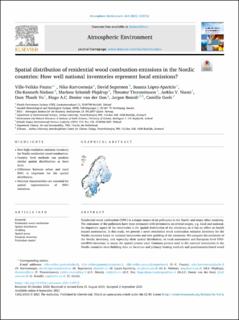| dc.contributor.author | Paunu, Ville-Veikko | |
| dc.contributor.author | Karvosenoja, Niko | |
| dc.contributor.author | Segersson, David | |
| dc.contributor.author | Lopez-Aparicio, Susana | |
| dc.contributor.author | Nielsen, Ole-Kenneth | |
| dc.contributor.author | Plejdrup, Marlene S. | |
| dc.contributor.author | Thorsteinsson, Throstur | |
| dc.contributor.author | Niemi, Jarkko V | |
| dc.contributor.author | Vo, Dam Thanh | |
| dc.contributor.author | van der Gon, Hugo A.C. Denier | |
| dc.contributor.author | Brandt, Jørgen | |
| dc.contributor.author | Geels, Camilla | |
| dc.date.accessioned | 2021-09-15T10:55:15Z | |
| dc.date.available | 2021-09-15T10:55:15Z | |
| dc.date.created | 2021-09-14T15:24:43Z | |
| dc.date.issued | 2021 | |
| dc.identifier.citation | Atmospheric Environment. 2021, 264, 118712. | en_US |
| dc.identifier.issn | 1352-2310 | |
| dc.identifier.uri | https://hdl.handle.net/11250/2777394 | |
| dc.description.abstract | Residential wood combustion (RWC) is a major source of air pollutants in the Nordic and many other countries. The emissions of the pollutants have been estimated with inventories on several scopes, e.g. local and national. An important aspect of the inventories is the spatial distribution of the emissions, as it has an effect on health impact assessments. In this study, we present a novel residential wood combustion emission inventory for the Nordic countries based on national inventories and new gridding of the emissions. We compare the emissions of the Nordic inventory, and especially their spatial distribution, to local assessments and European level TNO-newRWC-inventory to assess the spatial proxies used. Common proxies used in the national inventories in the Nordic countries were building data on locations and primary heating methods and questionnaire-based wood use estimates for appliances or primary heating methods. Chimney sweeper register data was identified as good proxy data, but such data may not be available in an applicable format. Comparisons of national inventories to local assessments showed the possibility to achieve similar spatial distributions through nation-wide methods as local ones. However, this won't guarantee that the emissions are similar. Comparison to the TNO-newRWC-inventory revealed the importance of how differences between urban and rural residential wood combustion are handled. The comparison also highlighted the importance of local characteristics of residential wood combustion in the spatial distribution of emissions. | en_US |
| dc.language.iso | eng | en_US |
| dc.rights | Navngivelse 4.0 Internasjonal | * |
| dc.rights.uri | http://creativecommons.org/licenses/by/4.0/deed.no | * |
| dc.title | Spatial distribution of residential wood combustion emissions in the Nordic countries: How well national inventories represent local emissions? | en_US |
| dc.type | Peer reviewed | en_US |
| dc.type | Journal article | en_US |
| dc.description.version | publishedVersion | en_US |
| dc.rights.holder | © 2021 The Author(s). Published by Elsevier Ltd. | en_US |
| dc.source.volume | 264 | en_US |
| dc.source.journal | Atmospheric Environment | en_US |
| dc.identifier.doi | 10.1016/j.atmosenv.2021.118712 | |
| dc.identifier.cristin | 1934262 | |
| dc.relation.project | NILU - Norsk institutt for luftforskning: 120011 | en_US |
| dc.relation.project | NILU - Norsk institutt for luftforskning: 115544 | en_US |
| dc.relation.project | Nordforsk: 75007 | en_US |
| dc.source.articlenumber | 118712 | en_US |
| cristin.ispublished | true | |
| cristin.fulltext | original | |
| cristin.qualitycode | 1 | |

